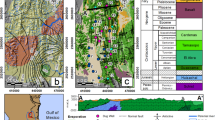Abstract
Groundwater is as an important geological agent. Moving groundwater may change the geological environment and cause geological hazards. Therefore, the interaction between groundwater and geo-environment has attracted increasing attention of hydrogeologists, geotechnical engineers and environmental geologists. In general, three main types of interaction between groundwater and the geological environment are identified in this paper, with several special processes for each one. These types include physical interaction, with processes of lubrication, softening or weakening and strengthening of bound water, chemical interaction with processes of ion exchange, dissolution, hydration, hydrolysis, corrosion and oxidation-reduction, and mechanical interaction with processes of hydrostatic pressure and hydrodynamic pressure. The interactions between groundwater and the geological environment can affect the deformability and strength of rock or soil masses. The geological process, engineering activity and heat can change the geo-stress field, recharge, throughflow and discharge conditions of groundwater. The consequence of interactions between groundwater flow and geo-stress changes the geological environment. Meanwhile, the interaction processes can induce geological hazards, such as reservoir-induced earthquakes, landslides, flooding of mines, ground engineering hazards, instability of dams, the collapse of cavities in carbonate and evaporate rocks, land subsidence and earthquakes.
Similar content being viewed by others
References
Aydin A (2001) Fracture void structure implications for flow, transport and deformation. Environ Geol 40(6):672–677
Bai M, Elsworth D (1994) Modeling of subsidence and stress-dependent hydraulic conductivity for intact and fractured porous media. Rock Mech Rock Eng 27:209–234
Bai M, Meng F, Elsworth D, Zaman M, Roegiers J-C (1997) Numerical modeling of stress-dependent permeability. Int J Rock Mech Min Sci 34:446
Dobson DP, Meredith PG, Boon SA (2002) Simulation of subduction zone seismicity by dehydration of serpentine. Science 298:1407–1409
Healy JH (1975) Recent highlights and future trends in research on earthquake prediction and control. Rev Geophys Space Phys 13:361–364
Hubbert MK, Rubey WW (1959) Role of fluid pressures in mechanics of overthrust faulting (1): mechanics of fluid-flow porous solids and its application to overthrust faulting. Bull Geol Soc Am 70:115–166
Ingebritsen SE, Sanford WE (2000) Groundwater in geologic processes. Cambridge University Press, Cambridge, 365 pp
Jing L, Tsang C-F, Stephansson O (1995) DECOVALEX: an international co-operative project on mathematical models of coupled THM processes for safety analysis of radioactive waste repositories. Int J Rock Mech Min Sci Geomech 32(5):389–398
Louis C (1969) A study of groundwater flow in rock masses and its influence on stability of rock masses. Rock Mechanics Report No 10, Imperial College, London, 90 pp
Louis C (1974) Introduction a l'hydraulique des roches. Bull Bur Rech Geol Minier 3–4:283–356
Nagaraj TS, Pandian NS, Narasimha Raju PSR (1994) Stress-state-permeability relations for over-consolidated clays. Geotechnique 46:363–366
Noorishad J (1982) A finite element method for coupled stress and flow analysis in fractured rock mass. Int J Rock Mech Min Sci Geomech 19:185–193
Noorishad J (1989) Coupled thermal-hydraulic-mechanical phenomena in saturated fractured porous rocks: numerical approach. J Geophys Res B12:10365–10373
Oda A (1985) Permeability tensor for discontinuous rock masses. Geotechnique 35:483–495
Oda M (1986) An equivalent continuum model for coupled stress and fluid flow analysis in jointed rock masses. Water Resour Res 22:1845–1856
Snow DT (1968) Fracture deformation and changes of permeability and storage upon changes of fluid pressure. Q J Colorado School Mines 63(1):201–244
Stephansson O (1995) Introduction to special issue on T–H–M coupling in rock mechanics. Int J Rock Mech Min Sci Geomech 32(5):387
Terzaghi K (1925) Erdbaumechanic auf Bodenphysikalischer Grundlage (Geological engineering based on soil-mechanical principles). Franz Deuticke, Leipzig 399 pp
Tsang C-F, Stephansson O (1996) A conceptual introduction to coupled thermo–hydro–mechanical processes in fractured rocks. In: Stephansson O, Jing L, Tsang C-F (eds) Coupled thermo-hydro–mechanical processes of fractured media, mathematical and experimental studies developments in geotechnical engineering, vol 79. Elsevier, Amsterdam pp 1–24
Witherspoon PA, Wang JSY, Iwai K, Gale JE (1980) Validity of cubic law in a deformable rock fracture. Water Resour Res 16:1016–1024
Wu Y (1997) A generalized double porosity media model for coupled stress and seepage fields in fractured rock mass. In: Proceedings of the International Symposium of the Engineering Geology and Environment, Athens, Greece, 23–27 June. A A Balkema, Rotterdam, pp 2913–2918
Wu Y (1998) On mechanical property of rock or soil masses by the action of seepage. In: Proceedings of the 8th International Congress of the International Association for Engineering Geology and the Environment. A A Balkema, Rotterdam, pp 3481–3486
Wu Y, Chai J (2001) Analysis of seepage forces exerted on fracture network of rock mass (In Chinese). J Eng Geol 1:24–28
Wu Y, Gao R (1997) A continuum model of coupled stress, temperature and fluid pressure fields effect on oil–gas migration (in Chinese). J Xi'an Univ Technol 3:204–209
Wu Y, Gao R (1998) A double porosity media model of coupled stress, temperature and fluid pressure fields effect on oil–gas migration (In Chinese). J Xi'an Univ Technol 2:113–143
Wu Y, Zhang Z (1994) Research on lumped parameter model of coupled seepage and stress field in fractured rock mass. In: Proceedings of the Seventh International Congress of the International Association of Engineering Geology. AA Balkema, Rotterdam, pp 4601–4604
Wu Y, Zhang Z (1995) Introduction to rock mass hydraulics. Southwest Jiaotong University Press, 172 pp
Zhang M, Esaki T, Olsen HW, Mitani Y (1997) Integrated shear and flow parameter measurement. Geotech Test J 20(3):296–303
Acknowledgements
This work was supported by a grant from the Innovation Project of CAS (KZCX1-10-03), the National Natural Science Foundation of China (90102003, 10172071), the Innovation Project of CAS (KZCX210021) and the Project of the Education Department of China (00233). The author wishes to thank the anonymous reviewers for their reading of the manuscript and for their suggestions and critical comments.
Author information
Authors and Affiliations
Corresponding author
Rights and permissions
About this article
Cite this article
Wu, Y. Mechanism analysis of hazards caused by the interaction between groundwater and geo-environment. Env Geol 44, 811–819 (2003). https://doi.org/10.1007/s00254-003-0819-9
Received:
Accepted:
Published:
Issue Date:
DOI: https://doi.org/10.1007/s00254-003-0819-9




